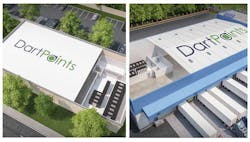Containerization 101: What you Need to Know
In this edition of Voices of the Industry, Brad Alexander, Chief Technology Officer at DartPoints shares six key benefits of containerization, including how it can reduce the strain of increasing IT demands.
Brad Alexander, Chief Technology Officer, DartPoints
Containerization. While at first blush it might seem like a buzz word thrown around at Crate and Barrel, in our data-hungry society, it has much greater implications. As an increasing amount of our day-to-day activities have at least one foot in the internet, we are generating a nearly incomprehensible amount of data. So much that we could not even count it if we tried, but best estimates put us at 44 zettabytes in 2020, and one zettabyte is enough storage space to hold 30 billion 4K movies. Nowhere is this strain felt more than on our existing network and IT infrastructure. Containerization is a way to reduce this strain by freeing up more resources and simplifying your software and application needs. Clear as mud?
The What and Why of Containerization
In simple terms, containerization is a form of virtualization in which applications are bundled so they can more easily be transferred between environments. This aggregation allows the software or app to run in repeatable external environments, isolated from any operating system.
The containers host the application along with the entirety of the necessary components, such as the libraries, binaries, configurations and anything else the application may need to run. These containers are essentially a single aggregated bundle that now holds all the app’s code and configurations that it will need to run — and all without an operating system.
This is the “isolation” portion of containerization. This isolation allows your applications to run on a variety of infrastructure configurations, which in turn allows software developers to deploy software securely, quickly, and with fewer errors. Containers are essentially a miniature, fully functional and portable computing environment. Moving these environments around, sans a specific operating system, is much simpler and less buggy, allowing for more widely operational software.
Containerization allows software and applications to be run on any device or infrastructure. With so many options when it comes to operating systems, this is essential to streamlining the process of app development. From Windows to Linux, Apple to Android (and lots in-between), try to imagine if software developers had to create new code from scratch for every conceivable operating system in which it might be used. Not good. Containerization eliminates this possibility.
What Are the Benefits of Containerization?
The applications are removed from any operating system into a single, executable package that runs an open source runtime engine at the host location. This becomes the means that allows the application to run in new environments — freeing up resources as developers won’t have to make unnecessary adjustments to code, and ensuring that software can run consistently in whatever other environments you may need to be in. This is only one of the major benefits of containerization.
Containerization has several benefits, ranging from ease of deployment to better resource allocation when compared to other similar processes like virtualization. Some of the major benefits of containerization are:
- Agility: The developer tools necessary for containerization are relatively simple to use, especially when compared to the alternative virtual machines (or VMs). Open source tools like the Docker Engine have streamlined the packaging process that makes containerization possible, allowing software developers to deploy applications much more quickly.
- Speed: Software development is not the only thing that gets faster when it comes to containerization. Containers are considered “lightweight,” which means they are not burdened with extra overhead because they share the operating system of their environment. This drives higher server efficiencies and speeds up start times, since the application is not running its own OS.
- Efficiency: Containers are smaller in capacity than a VM because, as mentioned, they share the OS with the environment they are running on. Because of this, more containers can run on the same computation capacity as one VM, which also drives higher server efficiencies.
- Security and Stability: Isolating applications into containers not only makes it easier to move your applications between environments, it also protects your host environments. The isolation process can include security permissions that protect from malicious code infecting your application by restricting external components from entering your container. And, since each application in your container is isolated from the others, the failure of one does not affect operations. Because they operate separately from one another, you won’t see across-the-board failures due to faults in one application, and this can allow development teams to easily correct any issues in one container without any downtime.
- Easier to Manage and Scale: One of the most game-changing benefits of containerization is the ability to deploy a container orchestration platform. This automates container management, streamlining tasks like scaling, app updates, monitoring, debugging and more. When you employ a container orchestration platform, you can free up your team to focus on other tasks while the platform simplifies tasks that would otherwise be pretty time consuming.
- Cost Reduction: Many containerization options exist in the open source format, which can make access and moving between vendors easier and more cost effective, so you can make changes without unnecessary expenditure. And, with all the ease that containerizing offers, you free up staff to focus on other revenue-building activities.
The Takeaways
At its core, containerization aims to ease workloads and make it simpler to run applications in any environment. Containers are the next iteration of virtualization. They offer a lot of automated benefits like load balancing, inherent scalability, the ability to understand what geographies you’re in and to deliver and protect data – processes that have historically been manual. This solution to what is a very time consuming and costly task frees up resources and makes workloads more easily manageable and secure.
As IT demands continue to increase, containerization is a next-gen solution to the strain of these demands. While shifting to containerized applications might seem like a daunting task, your workloads, teams and bottom line will thank you for it.





